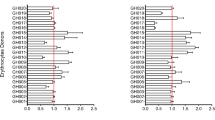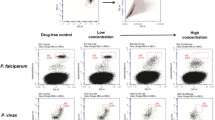Abstract
Having the ability to rapidly, accurately, and robustly measure Plasmodium falciparum merozoite invasion is a critical component in effective assessment of a blood stage vaccine’s mechanism of action. Being able to measure invasion of erythrocytes accurately, objectively and in a high throughput fashion is of critical importance. Here, we describe a simple and robust flow cytometry method that allows for the measurement of the key invasion parameters of parasite multiplication rate and erythrocyte selectivity—both important determinants of disease severity—from the schizont to the ring stage of the parasite’s life-cycle, thus separating invasion from growth of the parasite. Importantly, this method is able to accurately detect low levels of parasitemia and heterogeneity within the population that can be missed by enzymatic methods. Lastly, this method has been successfully adapted and employed in field based research settings for parasitemia measurements in vivo, ex vivo, and in vitro and to measure invasion inhibition by antibodies and the use of alternative pathways for invasion.
Access this chapter
Tax calculation will be finalised at checkout
Purchases are for personal use only
Similar content being viewed by others
References
Wright GJ, Rayner JC (2014) Plasmodium falciparum erythrocyte invasion: combining function with immune evasion. PLoS Pathog 10(3), e1003943
Crabb BS, Beeson JG (2005) Promising functional readouts of immunity in a blood-stage malaria vaccine trial. PLoS Med 2(11), e380
Richards JS, Beeson JG (2009) The future for blood-stage vaccines against malaria. Immunol Cell Biol 87(5):377–390
Simpson JA, Silamut K, Chotivanich K, Pukrittayakamee S, White NJ (1999) Red cell selectivity in malaria: a study of multiple-infected erythrocytes. Trans R Soc Trop Med Hyg 93(2):165–168
Chotivanich K, Udomsangpetch R, Simpson JA, Newton P, Pukrittayakamee S, Looareesuwan S, White NJ (2000) Parasite multiplication potential and the severity of Falciparum malaria. J Infect Dis 181(3):1206–1209
Walliker D, Sanderson A, Yoeli M, Hargreaves BJ (1976) A genetic investigation of virulence in a rodent malaria parasite. Parasitology 72(2):183–194
Bungener W (1985) Virulence of plasmodium yoelii line YM is caused by altered preference for parasitized and unparasitized immature and mature erythrocytes. Trop Med Parasitol 36(1):43–45
Deans A-M, Nery S, Conway DJ, Kai O, Marsh K, Rowe JA (2007) Invasion pathways and malaria severity in Kenyan Plasmodium falciparum clinical isolates. Infect Immun 75(6):3014–3020
Bei AK, Brugnara C, Duraisingh MT (2010) In vitro genetic analysis of an erythrocyte determinant of malaria infection. J Infect Dis 202:1722–1727
Reed MB, Caruana SR, Batchelor AH, Thompson JK, Crabb BS, Cowman AF (2000) Targeted disruption of an erythrocyte binding antigen in Plasmodium falciparum is associated with a switch toward a sialic acid-independent pathway of invasion. Proc Natl Acad Sci U S A 97(13):7509–7514
Duraisingh MT, Maier AG, Triglia T, Cowman AF (2003) Erythrocyte-binding antigen 175 mediates invasion in Plasmodium falciparum utilizing sialic acid-dependent and -independent pathways. Proc Natl Acad Sci U S A 100(8):4796–4801
Duraisingh MT, Triglia T, Ralph SA, Rayner JC, Barnwell JW, McFadden GI, Cowman AF (2003) Phenotypic variation of Plasmodium falciparum merozoite proteins directs receptor targeting for invasion of human erythrocytes. EMBO J 22(5):1047–1057
Baum J, Pinder M, Conway DJ (2003) Erythrocyte invasion phenotypes of Plasmodium falciparum in The Gambia. Infect Immun 71(4):1856–1863
Bei AK, Membi CD, Rayner JC, Mubi M, Ngasala B, Sultan AA, Premji Z, Duraisingh MT (2007) Variant merozoite protein expression is associated with erythrocyte invasion phenotypes in Plasmodium falciparum isolates from Tanzania. Mol Biochem Parasitol 153(1):66–71
Jennings CV, Ahouidi AD, Zilversmit M, Bei AK, Rayner J, Sarr O, Ndir O, Wirth DF, Mboup S, Duraisingh MT (2007) Molecular analysis of erythrocyte invasion in Plasmodium falciparum isolates from Senegal. Infect Immun 75(7):3531–3538
Lantos PM, Ahouidi AD, Bei AK, Jennings CV, Sarr O, Ndir O, Wirth DF, Mboup S, Duraisingh MT (2009) Erythrocyte invasion profiles are associated with a common invasion ligand polymorphism in Senegalese isolates of Plasmodium falciparum. Parasitology 136(1):1–9
Gomez-Escobar N, Amambua-Ngwa A, Walther M, Okebe J, Ebonyi A, Conway DJ (2010) Erythrocyte invasion and merozoite ligand gene expression in severe and mild Plasmodium falciparum malaria. J Infect Dis 201(3):444–452
Persson KEM, McCallum FJ, Reiling L, Lister NA, Stubbs J, Cowman AF, Marsh K, Beeson JG (2008) Variation in use of erythrocyte invasion pathways by Plasmodium falciparum mediates evasion of human inhibitory antibodies. J Clin Invest 118(1):342–351
Egan AF, Burghaus P, Druilhe P, Holder AA, Riley EM (1999) Human antibodies to the 19 kDa C-terminal fragment of Plasmodium falciparum merozoite surface protein 1 inhibit parasite growth in vitro. Parasite Immunol 21(3):133–139
Douglas AD, Williams AR, Illingworth JJ, Kamuyu G, Biswas S, Goodman AL, Wyllie DH, Crosnier C, Miura K, Wright GJ, Long CA, Osier FH, Marsh K, Turner AV, Hill AV, Draper SJ (2011) The blood-stage malaria antigen PfRH5 is susceptible to vaccine-inducible cross-strain neutralizing antibody. Nat Commun 2:601
Rayner JC, Vargas-Serrato E, Huber CS, Galinski MR, Barnwell JW (2001) A Plasmodium falciparum homologue of Plasmodium vivax reticulocyte binding protein (PvRBP1) defines a trypsin-resistant erythrocyte invasion pathway. J Exp Med 194(11):1571–1581
Miura K, Zhou H, Moretz SE, Diouf A, Thera MA, Dolo A, Doumbo O, Malkin E, Diemert D, Miller LH, Mullen GED, Long CA (2008) Comparison of biological activity of human anti-apical membrane antigen-1 antibodies induced by natural infection and vaccination. J Immunol 181(12):8776–8783
Crosnier C, Bustamante LY, Bartholdson SJ, Bei AK, Theron M, Uchikawa M, Mboup S, Ndir O, Kwiatkowski DP, Duraisingh MT, Rayner JC, Wright GJ (2011) Basigin is a receptor essential for erythrocyte invasion by Plasmodium falciparum. Nature 480:534–537
Patel SD, Ahouidi AD, Bei AK, Dieye TN, Mboup S, Harrison SC, Duraisingh MT (2013) Plasmodium falciparum merozoite surface antigen, PfRH5, elicits detectable levels of invasion-inhibiting antibodies in humans. J Infect Dis 208(10):1679–1687
Bei AK, Patel SD, Volkman SK, Ahouidi AD, Ndiaye D, Mboup S, Wirth DF (2014) An adjustable gas-mixing device to increase feasibility of in vitro culture of Plasmodium falciparum parasites in the field. PLoS One 9(3), e90928
Malkin EME, Diemert DJD, McArthur JHJ, Perreault JRJ, Miles APA, Giersing BKB, Mullen GEG, Orcutt AA, Muratova OO, Awkal MM, Zhou HH, Wang JJ, Stowers AA, Long CAC, Mahanty SS, Miller LHL, Saul AA, Durbin APA (2005) Phase 1 clinical trial of apical membrane antigen 1: an asexual blood-stage vaccine for Plasmodium falciparum malaria. Infect Immun 73(6):3677–3685
Bei AK, Desimone TM, Badiane AS, Ahouidi AD, Dieye T, Ndiaye D, Sarr O, Ndir O, Mboup S, Duraisingh MT (2010) A flow cytometry-based assay for measuring invasion of red blood cells by Plasmodium falciparum. Am J Hematol 85(4):234–237
Theron M, Hesketh RL, Subramanian S, Rayner JC (2010) An adaptable two-color flow cytometric assay to quantitate the invasion of erythrocytes by Plasmodium falciparum parasites. Cytometry A 77(11):1067–1074
Zipper H, Brunner H, Bernhagen J, Vitzthum F (2004) Investigations on DNA intercalation and surface binding by SYBR Green I, its structure determination and methodological implications. Nucleic Acids Res 32(12), e103
Janse CJ, Ponnudurai T, Lensen AH, Meuwissen JH, Ramesar J, Van der Ploeg M, Overdulve JP (1988) DNA synthesis in gametocytes of Plasmodium falciparum. Parasitology 96(Pt 1):1–7
Grimberg BT, Erickson JJ, Sramkoski RM, Jacobberger JW, Zimmerman PA (2008) Monitoring Plasmodium falciparum growth and development by UV flow cytometry using an optimized Hoechst-thiazole orange staining strategy. Cytometry A 73(6):546–554
Shapiro HM, Apte SH, Chojnowski GM, Hanscheid T, Rebelo M, Grimberg BT (2013) Cytometry in malaria—a practical replacement for microscopy? Curr Protoc Cytom Chapter 11:Unit 11.20
Jogdand PS, Singh SK, Christiansen M, Dziegiel MH, Singh S, Theisen M (2012) Flow cytometric readout based on Mitotracker Red CMXRos staining of live asexual blood stage malarial parasites reliably assesses antibody dependent cellular inhibition. Malar J 11:235
Ribacke U, Moll K, Albrecht L, Ahmed Ismail H, Normark J, Flaberg E, Szekely L, Hultenby K, Persson KE, Egwang TG, Wahlgren M (2013) Improved in vitro culture of Plasmodium falciparum permits establishment of clinical isolates with preserved multiplication, invasion and rosetting phenotypes. PLoS One 8(7), e69781
Allen RJ, Kirk K (2010) Plasmodium falciparum culture: the benefits of shaking. Mol Biochem Parasitol 169(1):63–65
Acknowledgements
The authors would like to acknowledge Dr. Jeffrey Dvorin for critical reading of the manuscript.
Author information
Authors and Affiliations
Corresponding author
Editor information
Editors and Affiliations
Rights and permissions
Copyright information
© 2015 Springer Science+Business Media New York
About this protocol
Cite this protocol
Bei, A.K., Duraisingh, M.T. (2015). Measuring Plasmodium falciparum Erythrocyte Invasion Phenotypes Using Flow Cytometry. In: Vaughan, A. (eds) Malaria Vaccines. Methods in Molecular Biology, vol 1325. Humana Press, New York, NY. https://doi.org/10.1007/978-1-4939-2815-6_14
Download citation
DOI: https://doi.org/10.1007/978-1-4939-2815-6_14
Publisher Name: Humana Press, New York, NY
Print ISBN: 978-1-4939-2814-9
Online ISBN: 978-1-4939-2815-6
eBook Packages: Springer Protocols




